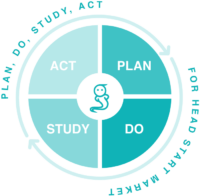Follow along and discover how our PDSA Framework for In-kind donations helped Agency B to meet their non-federal match, and how it can help your Agency achieving the same results.
If you aren’t familiar with the “Plan, Do, Study, Act Framework” we recommend you reading our explanatory post that you can find here. We also have an infographic that might help you better understand this process, find it here.
Agency B Family Center PDSA Implementation
As you might have already read in our introductory post, The PDSA framework is an ongoing practice to improve any problem or internal work process in Head Start Agencies. Here we are going to cover each of the four steps that led Agency B to success.
First stage: Plan.
In this stage, you agree with your team on the changes that will be tested and plan your actions to make them happen. Agency B identified the following changes and objectives that would make them improve their In-Kind collection.
1. Family Service staff to focus on achieving 100% family enrollment by December.
2. Use surveys to identify any possible issues with In-Kind collection before and after PDSA cycle is complete.
3. Monthly calendars to be created on Oct-Dec for site directors to follow-up.
4. Meetings to be set up for team levels to evaluate result.
Once Agency B identified the main areas that needed improvement, it was time to identify the actions that will help this change in the next stage of the cycle.
Agency B identified the following problems:
1. Low family onboarding.
2. Not many in-kind being submitted.
3. Value generated for that month is well below the amount needed to meet non-federal share match.
Second Stage: Do.
In this stage is time to apply the interventions needed to change the previous scenario. Agency B established the following actions in order to start making changes on their In-Kind problems:
1. Family Service staff to enroll families during enrollment intake, back to school night, and home visits.
2. Staff needs to assign activities, communicate with parents, send reminders and approve.
3. Site directors to set meetings on 3rd Friday of the month and submit reports to Agency Directors.
Monitor the results for a period of time. Collecting data is important in this step, so make sure you are documenting everything, as this data will be used in the next step of the cycle.
To meet the goals set, Agency B established these actions:
1. Tutorials sent to all families to ensure they are knowledgeable about submitting In-Kind activities.
2. Send surveys to families asking why they don’t submit In-Kind and how to help.
Third Stage: Study.
At this stage you will now need to study the data you have collected, which will be based on the results agreed at the planning stage.
1. Check onboarding reports to see if onboarding quota has improved.
2. Staff look at the data from classroom, site, and agency level on a monthly basis, so they can ensure to hit the monthly goal.
3. Review reports submitted.
Agency B must agree on what needs to be adjusted or dropped in order to obtain positive results by moving forward.
1. Hold a monthly meeting to review how the plan and do stage have been going.
At their monthly meeting, they were thrilled to see both Family Onboarding and In-Kind donations had been steadily increasing, a good sign that the PDSA cycle implementation was working.
Fourth Stage: Act.
For Agency B the act stage consisted in:
1. After reviewing the results from goals set at the monthly meeting, they identified that fatherhood engagement is still quite low
2. They re-group and brainstorm how they can tackle this.
3. The process starts all over again!








